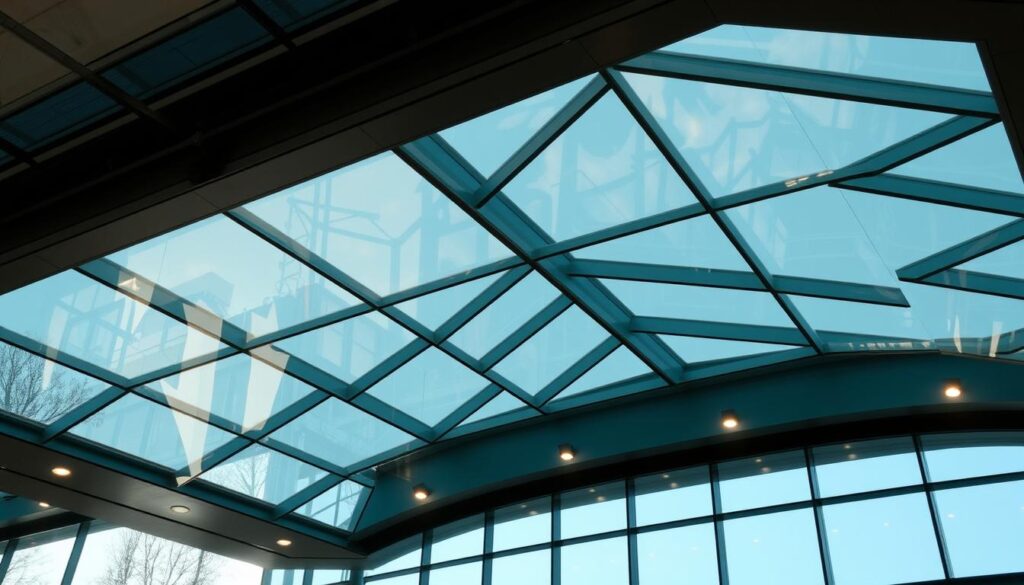Can a simple architectural feature transform the way we experience public spaces? The answer lies in the increasingly popular glass canopy design, which is redefining the boundaries of modern architecture.
As noted by Vitrum Glass & Mirror, glass canopies are becoming a defining feature in architectural innovation, seamlessly blending elegance, functionality, and innovation. They not only provide protection from the elements but also add an aesthetic dimension to public spaces, making them more inviting and engaging.
The incorporation of glass canopies in public space architecture is a testament to the evolving nature of urban design, where functionality meets aesthetics.
Key Takeaways
- Glass canopies are revolutionizing public space architecture.
- They offer both functional and aesthetic benefits.
- Innovative designs are making public spaces more inviting.
- Glass canopies provide protection from the elements.
- They are a key feature in modern architectural innovation.
Introduction to Glass Canopies
Glass canopies have become a staple in modern architectural glass structures, transforming public spaces with their elegance and functionality. These structures are not just aesthetically pleasing but also serve as a protective barrier against the elements.
As urban canopy design continues to evolve, glass canopies are being increasingly incorporated into public spaces, enhancing their visual appeal and usability.
What Are Glass Canopies?
Glass canopies are architectural features that provide shelter and add a touch of sophistication to buildings and public areas. According to ‘Aysh Groups,’ a glass canopy is not just a shelter but a statement piece that exudes elegance and sophistication.
“A glass canopy is not just a shelter but a statement piece that exudes elegance and sophistication.”
These canopies are designed to be durable and weather-resistant, making them ideal for various climates.
Importance in Public Spaces
The importance of glass canopies in public spaces cannot be overstated. They not only enhance the visual appeal of buildings but also provide shelter from the elements, making public areas more accessible and enjoyable.
| Benefits | Description |
|---|---|
| Aesthetic Appeal | Enhances the visual appeal of public spaces |
| Weather Protection | Provides shelter from rain, sun, and wind |
| Durability | Made from durable materials like tempered glass |
In conclusion, glass canopies play a significant role in urban canopy design, offering both functional and aesthetic benefits to public spaces.
Advantages of Glass Canopies
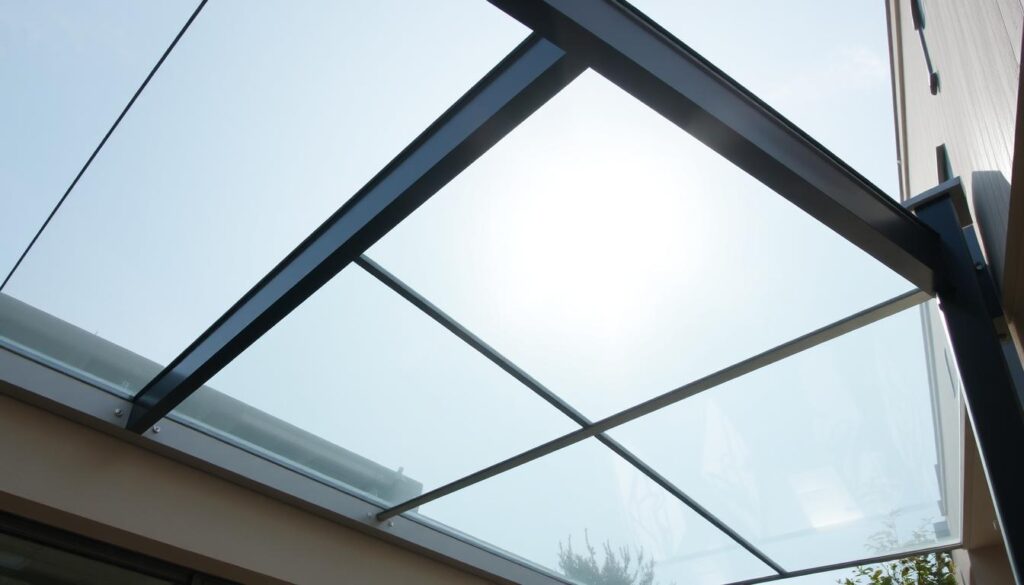
One of the most significant advantages of glass canopies is their ability to seamlessly blend functionality with aesthetics. This unique blend makes them an attractive feature in public spaces.
Aesthetic Appeal
Glass canopies are renowned for their sleek and modern canopy construction, which can significantly enhance the visual appeal of any public space. Their transparent canopy design allows for an unobstructed view, creating a sense of openness and grandeur.
The aesthetic versatility of glass canopies means they can be customized to fit various architectural styles, from contemporary to classic designs.
Natural Light Enhancement
One of the key benefits of glass canopies is their ability to infuse interiors with natural light. By allowing sunlight to penetrate through, they reduce the need for artificial lighting, creating a more welcoming and energy-efficient environment.
This natural light enhancement not only improves the ambiance of public spaces but also contributes to a more sustainable and environmentally friendly design.
Weather Protection
Glass canopies provide effective protection from various weather conditions, including rain, snow, and harsh sunlight. Their durability and strength ensure that they remain a safe and reliable feature in public spaces.
By offering weather protection, glass canopies enable the creation of outdoor or semi-outdoor areas that can be used throughout the year, regardless of the weather.
Key Design Considerations
Effective glass canopy design hinges on three primary considerations: structural integrity, adherence to safety standards, and environmental sustainability. These factors are crucial in ensuring that glass canopies are not only aesthetically pleasing but also safe and durable.
Structural Integrity
The structural integrity of a glass canopy is paramount. It must be able to withstand various environmental conditions such as wind, rain, and snow. According to structural glass design guidelines, the use of high-quality materials and robust framing systems is essential to ensure the canopy’s stability.
For instance, Vitrum Glass & Mirror emphasizes the importance of quality materials in glass canopy design. The choice of glass and framing materials significantly impacts the overall durability and structural integrity of the canopy.
Safety Standards
Safety is a critical consideration in the design of glass canopies. The canopy must be designed to prevent accidents and injuries. This involves adhering to strict safety standards, including the use of tempered or laminated glass to minimize the risk of breakage and injury.
‘Aysh Groups‘ highlights the need for durability and resistance to corrosion in glass canopy design, further emphasizing the importance of safety standards.
Environmental Sustainability
Environmental sustainability is becoming increasingly important in architectural design. Glass canopies can be designed to be eco-friendly by using sustainable materials and incorporating energy-efficient systems. For example, the use of insulated glass units can significantly reduce energy consumption.
For more detailed information on designing canopies and awnings, refer to the design guide on canopies and awnings, which provides comprehensive insights into sustainable design practices.
| Design Consideration | Key Factors | Benefits |
|---|---|---|
| Structural Integrity | High-quality materials, robust framing | Durability, stability |
| Safety Standards | Tempered or laminated glass, safety protocols | Reduced risk of injury, compliance with regulations |
| Environmental Sustainability | Sustainable materials, energy-efficient systems | Reduced environmental impact, energy savings |
Types of Glass Used in Canopies

The type of glass used in canopies significantly impacts their functionality and aesthetic appeal. The choice of glass can affect the overall performance of the canopy, including its durability, energy efficiency, and visual attractiveness.
Tempered Glass
Tempered glass, also known as toughened glass, is a popular choice for canopies due to its enhanced strength and safety features. It is processed by heat treatment to increase its durability and resistance to thermal stress. Tempered glass is up to five times stronger than regular glass, making it an ideal option for areas that require high safety standards.
Laminated Glass
Laminated glass consists of multiple layers of glass bonded together with an interlayer, typically made of polyvinyl butyral (PVB). This construction provides excellent impact resistance and holds the glass fragments together in the event of breakage. Laminated glass is often used in canopies to enhance security and reduce the risk of injury from falling glass shards.
Insulated Glass Units
Insulated glass units (IGUs) comprise two or more glass panes separated by a spacer, creating a gap that is usually filled with air or gas. This design significantly improves thermal insulation, reducing heat transfer and minimizing energy losses. IGUs are beneficial in canopies as they help maintain a comfortable temperature under the canopy and reduce energy consumption.
For more information on the materials used in structural glass, visit this resource to explore the various options available.
| Glass Type | Key Features | Benefits |
|---|---|---|
| Tempered Glass | Enhanced strength, thermal resistance | Safety, durability |
| Laminated Glass | Impact resistance, secure | Enhanced security, reduced risk of injury |
| Insulated Glass Units | Thermal insulation, energy efficiency | Energy savings, comfort |
Architectural Styles for Glass Canopies
Incorporating glass canopies into public spaces requires a thoughtful approach to architectural style, ensuring harmony with the surrounding environment. The design of these canopies can significantly impact the aesthetic and functional quality of urban areas.
Modern Designs
Modern glass canopies are characterized by their sleek lines, minimalist frames, and innovative use of materials. These designs often incorporate advanced technology, such as smart glass that can change opacity with the touch of a button.
Companies like Aysh Groups and Vitrum Glass & Mirror are at the forefront of modern glass canopy design, pushing the boundaries of what is possible in terms of aesthetics and functionality.
Classic Designs
Classic glass canopies, on the other hand, draw inspiration from historical architectural styles, featuring ornate details and traditional materials. These designs are often used to preserve the historical integrity of older buildings or areas.
The use of classic designs for glass canopies can add a touch of elegance and sophistication to public spaces, making them more appealing to visitors.
Integrating with Existing Architecture
Regardless of whether a modern or classic design is chosen, integrating the glass canopy with the existing architecture is crucial. This involves considering factors such as the color palette, materials, and overall style of the surrounding buildings.
A well-integrated glass canopy can enhance the visual appeal of a public space, creating a cohesive and inviting atmosphere.
| Design Style | Key Features | Benefits |
|---|---|---|
| Modern | Sleek lines, minimalist frames, advanced technology | Innovative, futuristic look, enhanced functionality |
| Classic | Ornate details, traditional materials, historical inspiration | Preserves historical integrity, adds elegance |
Customization Options
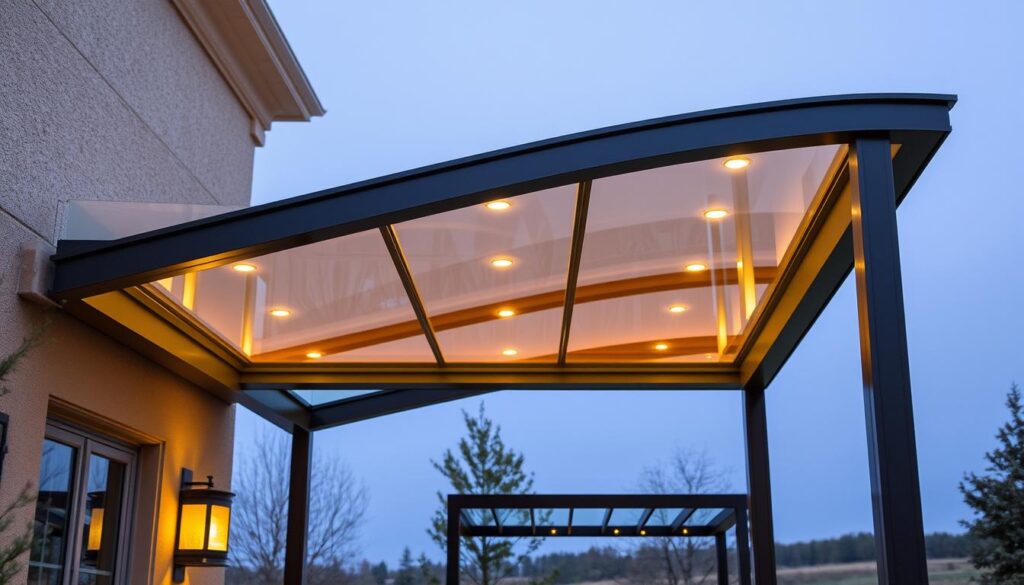
The versatility of glass canopies is evident in their numerous customization possibilities, allowing architects and designers to create unique structures that complement any building style.
Color and Coatings
One of the key customization options for glass canopies is the choice of color and coatings. Various coatings can be applied to glass to enhance its properties, such as UV protection or energy efficiency. For instance, a low-e coating can be used to minimize heat transfer, keeping spaces cooler in the summer and warmer in the winter.
Additionally, glass can be tinted in various colors to match the aesthetic of the surrounding architecture. This not only enhances the visual appeal but also provides an additional layer of customization. For more information on custom glass canopy designs, visit custom glass canopy designs.
Shapes and Styles
Glass canopies can be fabricated in a variety of shapes and styles to suit different architectural designs. From sleek, modern designs to more traditional or curvilinear shapes, the possibilities are vast. This flexibility allows for the creation of truly unique structures that can be a focal point of any building.
Size Variations
The size of glass canopies can also be customized to fit specific requirements. Whether it’s a small canopy over an entrance or a large, expansive canopy covering a public plaza, the size can be tailored to the project’s needs.
| Customization Aspect | Description | Benefits |
|---|---|---|
| Color and Coatings | Various coatings and tints available | Enhanced UV protection, energy efficiency, aesthetic appeal |
| Shapes and Styles | Range from modern to traditional designs | Flexibility in design, unique architectural features |
| Size Variations | Customizable sizes for different applications | Tailored to specific project requirements, functional and aesthetic |
Installation Process of Glass Canopies
The installation of glass canopies is a complex process that requires meticulous planning and execution. It involves several stages, from pre-installation planning to the actual installation, and finally, to ensuring that the structure meets all safety and aesthetic standards.
Pre-Installation Planning
Before the installation of glass canopies begins, thorough planning is essential. This includes assessing the site, determining the structural requirements, and ensuring compliance with local building codes. Proper planning helps in identifying potential challenges and devising strategies to address them.
Structural Support Requirements
The structural integrity of outdoor architectural structures like glass canopies is paramount. The installation process must include adequate support systems to bear the weight of the glass and withstand environmental factors such as wind and rain. This often involves working with structural engineers to design a support framework that is both functional and aesthetically pleasing.
| Structural Component | Function | Material |
|---|---|---|
| Frame | Provides support to the glass | Aluminum or Steel |
| Glass Panels | Transparent canopy design element | Tempered or Laminated Glass |
| Mounting System | Secures the canopy to the building | Stainless Steel or Brass |
Professional Installation vs. DIY
While DIY projects can be cost-effective, the installation of glass canopies is generally recommended to be handled by professionals. Professional installers bring expertise and experience, ensuring that the canopy is installed correctly and safely. They are also familiar with local regulations and can obtain necessary permits, making the process smoother for the property owner.
Maintenance of Glass Canopies
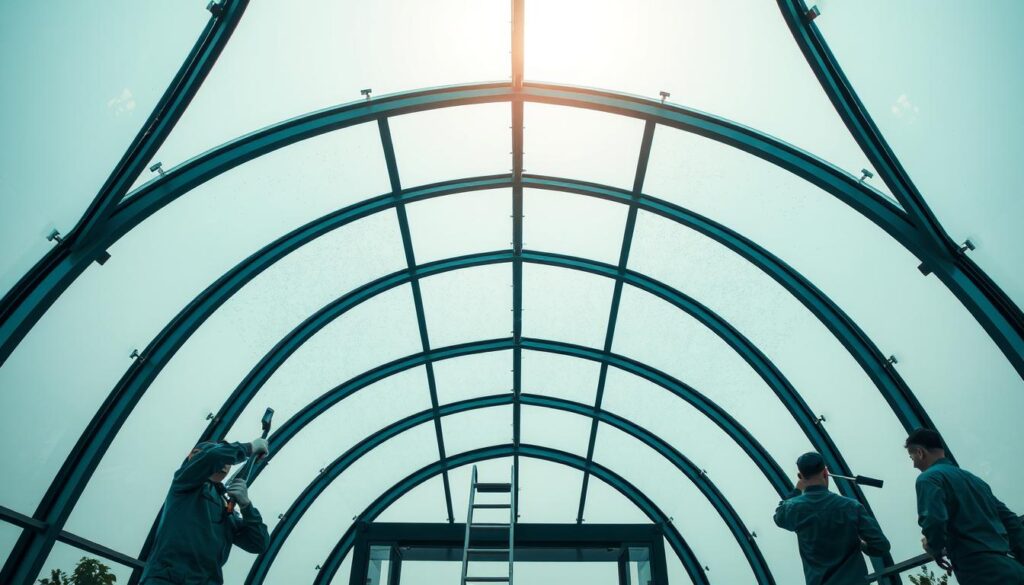
To keep glass canopies in optimal condition, a routine maintenance schedule is essential. This not only ensures their longevity but also maintains their aesthetic appeal and functionality.
Regular Cleaning Techniques
Cleaning is a critical aspect of maintaining glass canopies. It’s recommended to use a mild detergent mixed with water and a soft, lint-free cloth to avoid scratching the glass. Avoid using abrasive materials or harsh chemicals that could damage the glass or its coatings.
- Use a soft-bristled brush to remove debris from the canopy’s frame.
- Mix a solution of mild detergent and warm water.
- Dip a soft cloth into the solution, wring it out thoroughly, and wipe down the glass.
- Rinse the cloth and wipe down the glass again to remove any soap residue.
- Dry the glass with a clean, dry lint-free cloth to prevent water spots.
Inspecting for Damage
Regular inspections are vital to identify any potential issues before they become major problems. Check for signs of damage such as cracks, chips, or excessive wear on the glass or the structural components.
- Inspect the glass for any visible cracks or chips.
- Check the seals around the glass for any signs of deterioration.
- Examine the structural elements for rust, corrosion, or damage.
Addressing Common Issues
Addressing issues promptly is crucial to prevent further damage. Common problems include water leakage, structural damage, or glass deterioration.
Water Leakage: Check the seals and gaskets for any signs of wear or damage. Replace them if necessary.
Structural Damage: Consult a professional if you notice any damage to the structural components.
Glass Deterioration: For minor chips or cracks, consider professional repair. In severe cases, replacement may be necessary.
By following these maintenance guidelines, you can ensure that your glass canopy remains a safe and beautiful feature of your public space.
Cost Factors in Designing Canopies
The overall cost of a glass canopy design is determined by a combination of material, installation, and long-term value considerations. When planning a custom canopy design, it’s essential to understand these factors to make informed decisions.
Material Costs
Material costs are a significant component of the overall expense. The type and quality of glass used can greatly impact the cost. For instance, tempered glass and laminated glass are more expensive than regular glass due to their enhanced safety features and durability.
Here’s a breakdown of the material costs:
| Material | Cost Range | Description |
|---|---|---|
| Tempered Glass | $50 – $100 per sq. ft. | Strong and safe, ideal for high-traffic areas. |
| Laminated Glass | $60 – $120 per sq. ft. | Holds together when shattered, providing additional safety. |
| Insulated Glass Units | $80 – $150 per sq. ft. | Reduces heat transfer and noise, enhancing energy efficiency. |
Installation Expenses
Installation expenses are another critical factor. The complexity of the design, the size of the canopy, and the need for structural support can all influence installation costs. Professional installation is recommended to ensure that the canopy is securely and correctly fitted.
According to experts, “A well-designed and properly installed glass canopy can last for decades, making it a worthwhile investment for public spaces.”
“The key to a successful glass canopy installation lies in meticulous planning and execution.”
Long-term Value
While the initial costs of a glass canopy may seem high, they provide significant long-term value. By enhancing the aesthetic appeal of a public space and providing protection from the elements, glass canopies can increase foot traffic and potentially boost local businesses.
For modern canopy construction, considering the long-term benefits is crucial. As noted in a guide on cutting construction costs, investing in quality materials and installation can lead to reduced maintenance costs over time.
Case Studies of Public Spaces with Glass Canopies
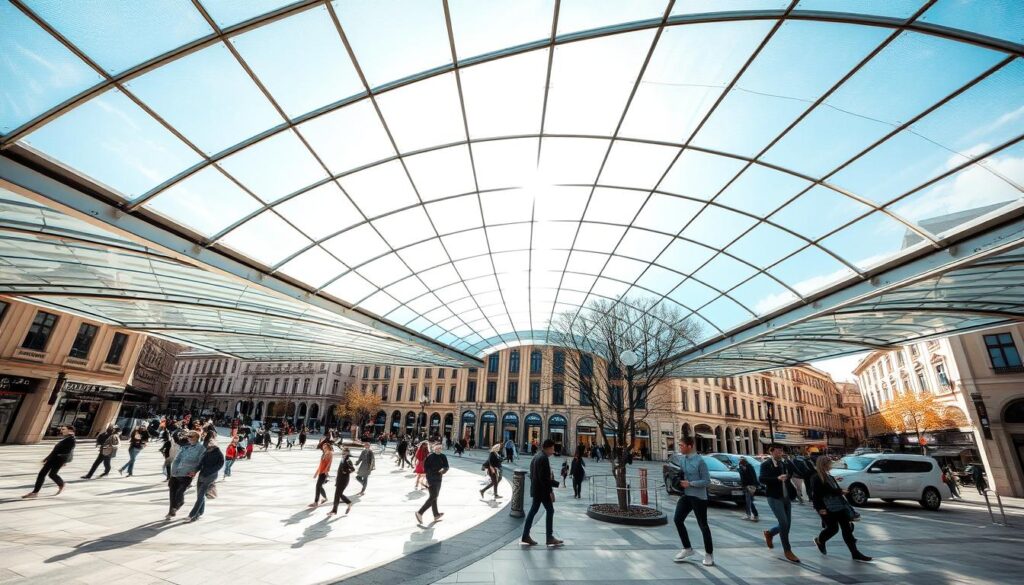
The incorporation of glass canopies in public spaces has revolutionized the way we experience urban environments. By providing shelter from the elements while maintaining a connection to the outdoors, glass canopies have become a popular choice for architects and urban planners.
Urban Parks
Urban parks are being transformed with the addition of glass canopies, creating inviting spaces for recreation and relaxation. For instance, a glass canopy in a city park can provide a sheltered area for community events, protecting attendees from harsh weather conditions while maintaining an open feel.
A notable example is the renovation of a downtown park, where a glass canopy was installed over a central plaza. This not only enhanced the aesthetic appeal of the park but also increased its usability throughout the year.
Transit Hubs
Transit hubs, such as train stations and bus terminals, benefit significantly from the installation of glass canopies. These structures provide passengers with shelter from rain and sun, improving their overall travel experience.
“The use of glass canopies in transit hubs represents a significant advancement in public space architecture, combining functionality with modern design principles.” –
Glass canopies in transit hubs also contribute to energy efficiency by reducing the need for artificial lighting and heating/cooling systems in covered areas.
Commercial Areas
In commercial areas, glass canopies are used to create vibrant and inviting shopping environments. By covering pedestrian walkways and outdoor shopping centers, glass canopies protect visitors from the elements, encouraging them to linger and explore.
- Enhance the shopping experience by providing shelter
- Contribute to the aesthetic appeal of commercial districts
- Support local businesses by creating more attractive and usable public spaces
The strategic use of glass canopies in public spaces, including urban parks, transit hubs, and commercial areas, demonstrates their versatility and potential to enhance community life.
Regulations and Permits
Understanding the regulatory framework is essential for the successful installation of glass canopies in public spaces. This involves navigating a complex landscape of regulations that ensure safety, compliance, and environmental sustainability.
The installation of architectural glass structures is subject to various regulatory requirements. These include building codes, which dictate the structural integrity and safety standards for such installations.
Building Codes
Building codes are critical in ensuring that outdoor architectural structures like glass canopies are designed and installed to withstand environmental stresses and ensure user safety. These codes vary by jurisdiction but typically cover aspects such as structural integrity, material specifications, and safety features.
Local Zoning Laws
Local zoning laws regulate how glass canopies can be used in public spaces, including their size, placement, and design. Compliance with these laws is crucial to avoid legal issues and ensure that the structures serve their intended purpose without conflicting with local ordinances.
Environmental Regulations
Environmental regulations play a significant role in the installation of glass canopies, particularly in sensitive ecosystems or areas of environmental concern. These regulations may dictate the materials used, the energy efficiency of the structure, and its impact on the surrounding environment.
In conclusion, the successful installation of glass canopies in public spaces requires a thorough understanding of and compliance with various regulations and permits. By adhering to building codes, local zoning laws, and environmental regulations, architects and builders can ensure that these architectural glass structures are both functional and compliant with legal requirements.
Innovative Technologies in Glass Canopy Design
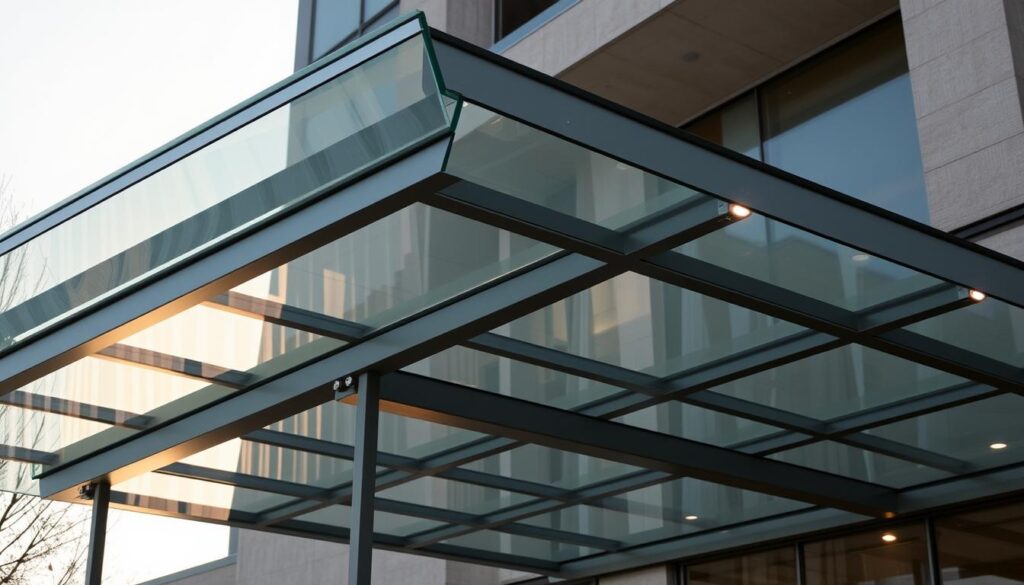
Glass canopy design is being transformed by cutting-edge technologies that enhance both functionality and sustainability. These advancements are not only improving the aesthetic appeal of glass canopies but also making them more efficient and environmentally friendly.
Smart Glass Solutions
Smart glass technology is one of the most significant innovations in glass canopy design. This technology allows glass to change its tint or transparency in response to various environmental factors, such as light or temperature. Smart glass can help reduce energy consumption by minimizing the need for artificial lighting and cooling systems.
The use of smart glass in canopies can also enhance user comfort by reducing glare and heat gain. For instance, electrochromic glass can change from clear to tinted with the application of a small electric current, providing an effective means of controlling light transmission.
Energy-efficient Systems
Energy-efficient systems are another crucial aspect of modern glass canopy design. These systems can include advanced insulation materials, solar panels, and energy-harvesting technologies. By integrating these systems into glass canopies, architects can create structures that not only provide shelter but also generate energy.
For example, incorporating photovoltaic cells into the glass canopy can allow it to harness solar energy, reducing the carbon footprint of the building. Additionally, advanced materials can improve thermal insulation, minimizing heat loss during colder months.
Interactive Displays
Interactive displays are an emerging trend in glass canopy design, offering new possibilities for public engagement and information dissemination. These displays can be integrated into the glass surface, providing a dynamic and interactive experience for users.
For instance, glass canopies with integrated LED displays can be used to convey information, display art, or even provide entertainment. This technology can enhance the user experience in public spaces, making them more engaging and enjoyable.
The integration of these innovative technologies is set to revolutionize the field of glass canopy design. As architects and designers continue to explore new possibilities, we can expect to see even more sophisticated and sustainable glass canopies in the future.
Future Trends in Glass Canopy Design
The future of glass canopy design is poised to revolutionize public spaces with innovative and sustainable solutions. As the demand for custom canopy design continues to grow, architects and designers are exploring new materials, designs, and functionalities to enhance the aesthetic and functional appeal of public spaces.
One of the key trends shaping the future of glass canopy design is the adoption of sustainable materials. This includes the use of recycled glass, low-iron glass, and other eco-friendly materials that reduce the environmental footprint of glass canopies.
Sustainable Materials
The use of sustainable materials in glass canopy design is becoming increasingly popular. Recycled glass, for instance, not only reduces waste but also adds a unique aesthetic to the canopy. Low-iron glass, with its high clarity and minimal green tint, is another material gaining traction for its ability to maximize natural light.
Modular Designs
Modularity is another trend transforming glass canopy design. Modular designs allow for greater flexibility and ease of installation, making it possible to create complex and customized canopy structures. This approach also facilitates easier maintenance and repair, as individual modules can be replaced without affecting the entire structure.
The benefits of modular designs include reduced installation time and lower costs. Moreover, modular canopies can be designed to be easily disassembled and reused, further enhancing their sustainability.
Enhanced Functionality
Future glass canopies are also expected to feature enhanced functionality, integrating technologies such as smart glass and energy-harvesting systems. Smart glass can change from transparent to opaque with the touch of a button, providing dynamic shading and privacy control. Energy-harvesting systems, on the other hand, can generate power from sunlight, reducing the energy consumption of the canopy and surrounding structures.
These innovations are set to redefine the role of glass canopies in public spaces, making them not just aesthetically pleasing but also highly functional and sustainable. As custom canopy design continues to evolve, we can expect to see more creative and technologically advanced glass canopies that enhance the urban landscape.
Conclusion: The Impact of Glass Canopies
Glass canopies have transformed public spaces, offering a blend of functionality and aesthetic appeal. Their incorporation into urban canopy design has redefined the way communities interact with their surroundings.
Transforming Public Spaces
Glass canopies enhance public space architecture by providing shelter from the elements while maintaining an open and airy feel. They increase property value, offer protection from UV rays, and are available in various designs to fit different themes.
Creating Lasting Impressions
The installation of glass canopies not only beautifies public areas but also leaves a lasting impression on communities. By providing a welcoming and comfortable environment, these structures foster community engagement and social interaction.
In conclusion, the impact of glass canopies on public spaces is multifaceted, influencing both the aesthetic and functional aspects of these areas. As urban canopy design continues to evolve, the role of glass canopies in shaping public space architecture will remain significant.
